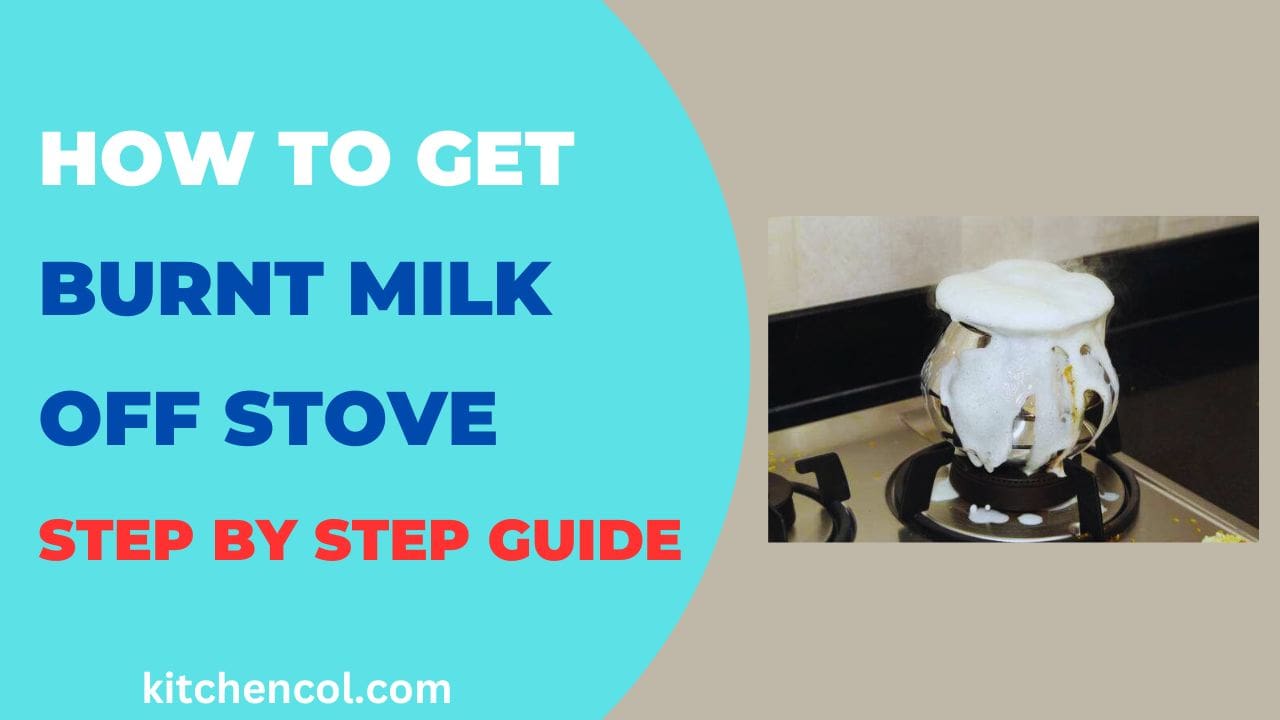Dealing with burnt milk stains on your stovetop can be a frustrating experience. The combination of heat and dairy can result in stubborn residue that seems impossible to remove. Not only are these stains unsightly, but they can also lead to odors, discoloration, and even damage to your stove if left untreated.
In this concise guide, we’ll walk you through a simple step-by-step process to effectively remove burnt milk stains and restore your stovetop to its pristine condition. With the right approach and a little effort, you can say goodbye to those stubborn stains and keep your kitchen looking its best.
Understanding the Problem
When it comes to cooking mishaps, burnt milk spills on your stovetop are among the most common and frustrating. The science behind this issue is rooted in the composition of milk and the way it reacts to heat. Milk contains proteins, sugars, and fats, all of which can undergo chemical changes when exposed to high temperatures.
As you heat milk on the stovetop, its water content evaporates, leaving behind concentrated solids. If the milk isn’t stirred frequently, these solids can stick to the surface of the stovetop and eventually burn, creating stubborn and unsightly stains.
The consequences of neglecting burnt milk stains can extend beyond mere aesthetics. The residue left behind can emit unpleasant odors when heated again, affecting the flavors of future dishes.
Additionally, the burnt milk can cause discoloration on the stovetop’s surface, particularly if it’s made of certain materials. Prolonged exposure to burnt milk can even lead to damage, as the heat and residue may corrode the stovetop’s finish over time.
In the next sections of this guide, we’ll delve into the steps you need to take to effectively tackle burnt milk stains and restore the cleanliness and functionality of your stovetop.
By understanding the science behind the issue and the potential consequences of ignoring it, you’re better equipped to take the necessary actions to prevent further damage and keep your kitchen in top shape.

Preparing for the Cleaning Process
Before you dive into the process of removing burnt milk stains from your stovetop, it’s essential to take a few preliminary steps to ensure both your safety and the effectiveness of the cleaning process.
Safety First:
The first thing to do is to turn off the stove if it’s still on. Safety should always be a priority, and you want to avoid any potential accidents while cleaning.
Cool Down:
Allow the stovetop to cool down before you begin cleaning. This not only prevents you from accidentally burning yourself but also makes the cleaning process more manageable as the burnt residue can harden when hot.
Gather Supplies:
Before you begin, gather all the cleaning supplies required. You’ll want to have everything on hand so you don’t have to interrupt the cleaning process to search for items. Items you’ll need include safety gloves, a soft sponge, mild dish soap, baking soda, vinegar, a plastic scraper or spatula, a cloth, and paper towels.
Ventilate the Area:
Cleaning burnt milk can release odorous fumes, so it’s a good idea to ventilate the area. Open windows and turn on any fans to help dissipate the smell and prevent it from lingering.
By taking these preparatory steps, you’re setting the stage for a smoother and more effective cleaning process. With safety ensured, the right tools at your disposal, and the environment properly ventilated, you’ll be ready to tackle those stubborn burnt milk stains head-on.
The Step-by-Step Cleaning Process
Now that you’ve prepared your workspace and gathered the necessary supplies, it’s time to roll up your sleeves and get to work on removing those burnt milk stains from your stovetop. Follow this step-by-step guide to ensure an efficient and effective cleaning process:
Scraping off the Surface:
- Start by gently scraping off any loose burnt milk residue using a plastic scraper or spatula. Be careful not to scratch the stovetop’s surface while doing so.
Creating a Cleaning Solution:
- For a simple cleaning solution, mix warm water with a few drops of mild dish soap. This will help break down the grease and grime left behind by the burnt milk.
- Alternatively, you can create a paste using baking soda and water. Baking soda is known for its gentle abrasive properties, which can help lift stubborn stains without damaging the stovetop.
Applying the Cleaning Solution:
- Dip a soft sponge into the soapy water solution or apply the baking soda paste directly to the burnt areas.
- Gently scrub the stains using a circular motion. Apply light pressure to avoid scratching the surface.
Targeted Cleaning for Stubborn Stains:
- If certain spots are particularly stubborn, you can try a more targeted approach. Moisten a cloth with vinegar and place it over the stubborn stain. Allow it to sit for a few minutes to help soften the residue.
Scrubbing and Wiping:
- After letting the vinegar-soaked cloth sit, use it to scrub the area again. You can also use the soft sponge to scrub if needed.
- As you scrub, you should notice the burnt milk residue beginning to lift.
Rinsing and Drying:
- Once you’ve successfully removed the stains, rinse the stovetop with clean water to remove any traces of the cleaning solution.
- Use a dry cloth or paper towels to thoroughly dry the surface. This helps prevent any water spots or streaks from forming.
By following these steps carefully, you’ll be able to effectively remove burnt milk stains from your stovetop. Whether you opt for the soapy water solution or the baking soda paste or even utilize vinegar for tougher spots, the key is to be patient and gentle while scrubbing. With a little effort and the right approach, you’ll soon have your stovetop looking clean and restored.
Preventing Future Incidents
Now that you’ve successfully tackled the issue of burnt milk stains on your stovetop, it’s time to focus on preventing these incidents from happening again in the future. By implementing some simple cooking and cleaning practices, you can maintain a clean and functional kitchen space. Here are some tips to consider:
Using Proper Cooking Techniques:
- Stirring Frequently: When heating milk or any other liquids on the stovetop, make sure to stir them regularly. Stirring prevents the milk from sticking to the bottom of the pot and minimizes the chances of it burning.
- Low to Medium Heat: Use low to medium heat settings when heating milk. High heat can cause milk to scorch quickly, leading to burnt residues.
Prompt Cleaning:
- Wipe Spills Immediately: Accidents happen, but cleaning up spills promptly can prevent them from becoming burnt-on stains. Keep a damp cloth or paper towels nearby to wipe up spills as soon as they occur.
- Regular Maintenance: Incorporate regular stovetop cleaning into your routine. Even if there are no visible spills, a quick wipe-down with a damp cloth can help prevent residue buildup.
Protective Measures:
- Use Pot Guards or Lids: When heating liquids like milk, consider using pot guards or lids to prevent splatters. This can help keep your stovetop cleaner during the cooking process.
- Nonstick Cooking Spray: For recipes involving milk, consider applying a light layer of nonstick cooking spray to the pot’s interior. This can make it easier to clean up any spills that may occur.
Learn from Experience:
- Adjust Cooking Times: If you’ve experienced burnt milk stains before, adjust your cooking times and techniques accordingly. Knowing how your stovetop heats and reacts to different temperatures will help you avoid future mishaps.
Regular Checkups:
- Inspect Burners and Elements: Regularly check your stovetop’s burners and heating elements for any residue or spillage. Cleaning them routinely can prevent future burnt milk incidents.
By incorporating these preventative measures into your cooking and cleaning routines, you can significantly reduce the likelihood of encountering burnt milk stains on your stovetop again. Remember that proactive care and attention to detail are the keys to maintaining a clean and functional kitchen environment.
Also Read: How to Vent A Kitchen Sink Under A Window-Ultimate Guide
Conclusion
Dealing with burnt milk stains on your stovetop might seem like a daunting task, but armed with the right knowledge and techniques, you can easily overcome this challenge and keep your kitchen looking its best.
By understanding the science behind why milk burns and sticks, you’re better equipped to prevent future incidents. Moreover, the consequences of neglecting burnt milk stains extend beyond aesthetics, making timely cleaning essential.
In this guide, we’ve taken you through a step-by-step process to effectively remove burnt milk stains from your stovetop.
From scraping off loose residue to using a cleaning solution or paste, and employing targeted methods for stubborn spots, each step is designed to restore your stovetop’s cleanliness and functionality.
The importance of safety, proper ventilation, and gathering the necessary supplies before you start cannot be overstated.
Furthermore, we’ve highlighted the significance of preventing future incidents by employing proper cooking techniques, promptly cleaning spills, and incorporating regular maintenance into your routine. With these practices in mind, you can ensure that burnt milk stains become a thing of the past.
In your journey towards a clean and functional kitchen, remember that a proactive approach is key.
By following the advice outlined in this guide and consistently practicing good kitchen hygiene, you’ll be well on your way to maintaining a kitchen space that is not only visually appealing but also conducive to preparing delicious meals without the worry of stubborn stains.
Your stovetop will thank you for the care and attention you’ve invested in keeping it pristine and ready for your culinary adventures.

My name is Manan Bukhari and I am an expert in reviewing kitchen products for years. I have a passion for testing multiple gadgets especially related to home & kitchen. I love to spend my free time in resolving issues if I face some in any of my daily use things. I have fixed multiple gadgets of my home on my own without any assistance and that thing gave me confidence to make a blog on troubleshooting of items that are for daily use to assist you folks. Even my wife praises me for having such talent. I always explore new machines on my own because this thing fascinates me.



